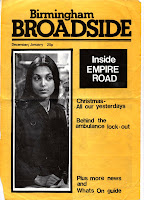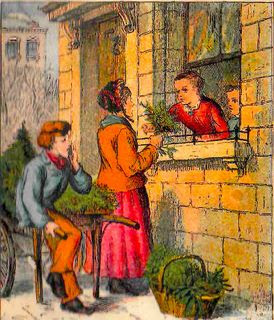 |
| Birmingham Broadside |
Some interesting bits abridged from an article that appeared in The Birmingham Broadside in the mid 70's -
Although Christmas (Cristes Maess) is the highpoint of the church calender, it has more in common with Saturnalia, a week long Roman Celebration, a period of general licence, excess and generosity to the poor.
Mithra's Birthday
 |
| Mithra |
The Yule Log
 |
| Yule Log |
Evergreens
Were a symbol of undying life and have always been used to decorate dwelling places, a pagan practice which the church tried to stamp out. Mistletoe is still banned in some churches though was once a custom in Wolverhampton for it to be placed on the alter by the priests and then distributed for its medicinal properties.
 |
| Mistletoe |
Mistletoe
Another local custom was to hang a bag of mistletoe round the neck to ward off evil spirits. Similar beliefs about the power of mistletoe existed as far a field as Japan and Africa. In Gaelic it means "All-healer" The Bilston people had another way of keeping evil spirits at bay - they drew chalk marks across either end of the street at Christmas. Mistletoe was held to be a cure for barrenness, but this has no connection with kissing under it, a purely English custom.
The Christmas Tree (Kissing Bough)
The kissing bough, a crown of greenery hung with decorations, was the forerunner of the tree which first appeared in the early 19thC, originating from Germany and coming to Britain via America.
Turkey
Turkey did not appear in Britain until 1542 and did not really become popular until much later. Goose, pork, beef, venison, swans, peacocks in their feathers (with gilded beaks) and above all - the boar's head, were it's predecessors.
 |
| Odin |
Plum porridge was the forerunner of Christmas pud and like the original mince pies contained meat as well as fruit and spices. Traditionally Christmas pudding had to be stirred by everyone in the making and wishes made with a few small charms thrown in.
Father Christmas
Has a long history. He was once Odin, a Norse god who went around at Yule on his giant horse, rewarding or punishing followers. When Christianity did away with the old gods, the part fell to St. Nicholas, a generous bishop in the fourth century. The real giving of gifts should take place on Boxing day, the feast of St. Stephen, when the contents of alms boxes were distributed to the poor. In the 16thC. it was common for the working people to carry a box for contributions.
Wassailing
An old practice stemming from Saxon days was Wassailing - a mild form of revelry. The poor went around singing with a bowl for contributions of money or drink, to drink one's health with. The favourite drink in the Black country was elderberry wine or warm ale sweetened and spiced, containing roasted apples. Cattle in their stalls were also wassailed on Twelfth night. In the West Midlands there was also a big celebration with dances and bonfires. Everyone in Walsall was entitled to Moseley's dole. This was a penny loaf given out annually, first recorded in 1539.
 |
| 12th Night |
It is no longer the custom to celebrate throughout the twelve days of Christmas despite a law of King Alfred to that effect. Few would be up to it anyway! Parliament did try to abolish all these goings on in 1644 but Christmas reappeared after the Restoration.
No comments:
Post a Comment